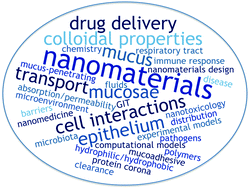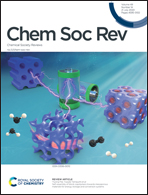Molecular and cellular cues governing nanomaterial–mucosae interactions: from nanomedicine to nanotoxicology
Abstract
Mucosal tissues constitute the largest interface between the body and the surrounding environment and they regulate the access of molecules, supramolecular structures, particulate matter, and pathogens into it. All mucosae are characterized by an outer mucus layer that protects the underlying cells from physicochemical, biological and mechanical insults, a mono-layered or stratified epithelium that forms tight junctions and controls the selective transport of solutes across it and associated lymphoid tissues that play a sentinel role. Mucus is a gel-like material comprised mainly of the glycoprotein mucin and water and it displays both hydrophilic and hydrophobic domains, a net negative charge, and high porosity and pore interconnectivity, providing an efficient barrier for the absorption of therapeutic agents. To prolong the residence time, absorption and bioavailability of a broad spectrum of active compounds upon mucosal administration, mucus-penetrating and mucoadhesive particles have been designed by tuning the chemical composition, the size, the density, and the surface properties. The benefits of utilizing nanomaterials that interact intimately with mucosae by different mechanisms in the nanomedicine field have been extensively reported. To ensure the safety of these nanosystems, their compatibility is evaluated in vitro and in vivo in preclinical and clinical trials. Conversely, there is a growing concern about the toxicity of nanomaterials dispersed in air and water effluents that unintentionally come into contact with the airways and the gastrointestinal tract. Thus, deep understanding of the key nanomaterial properties that govern the interplay with mucus and tissues is crucial for the rational design of more efficient drug delivery nanosystems (nanomedicine) and to anticipate the fate and side-effects of nanoparticulate matter upon acute or chronic exposure (nanotoxicology). This review initially overviews the complex structural features of mucosal tissues, including the structure of mucus, the epithelial barrier, the mucosal-associated lymphatic tissues and microbiota. Then, the most relevant investigations attempting to identify and validate the key particle features that govern nanomaterial–mucosa interactions and that are relevant in both nanomedicine and nanotoxicology are discussed in a holistic manner. Finally, the most popular experimental techniques and the incipient use of mathematical and computational models to characterize these interactions are described.



 Please wait while we load your content...
Please wait while we load your content...